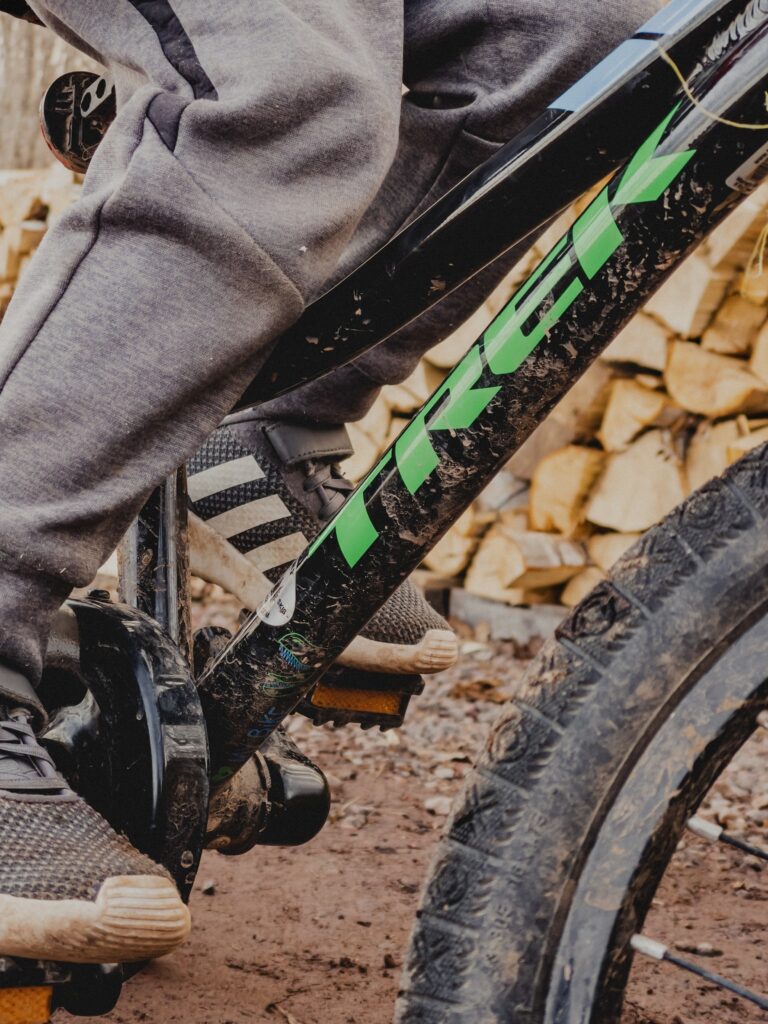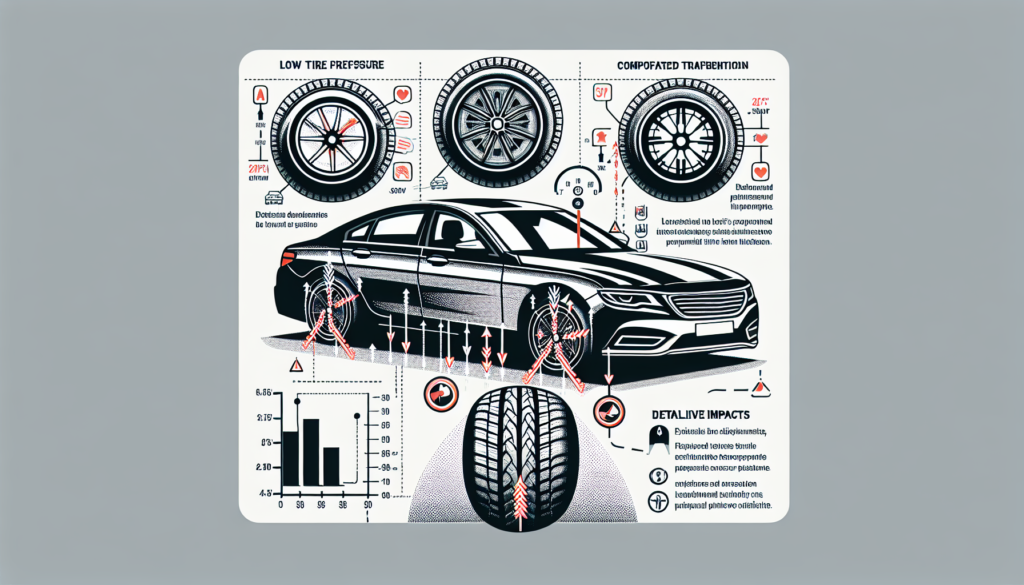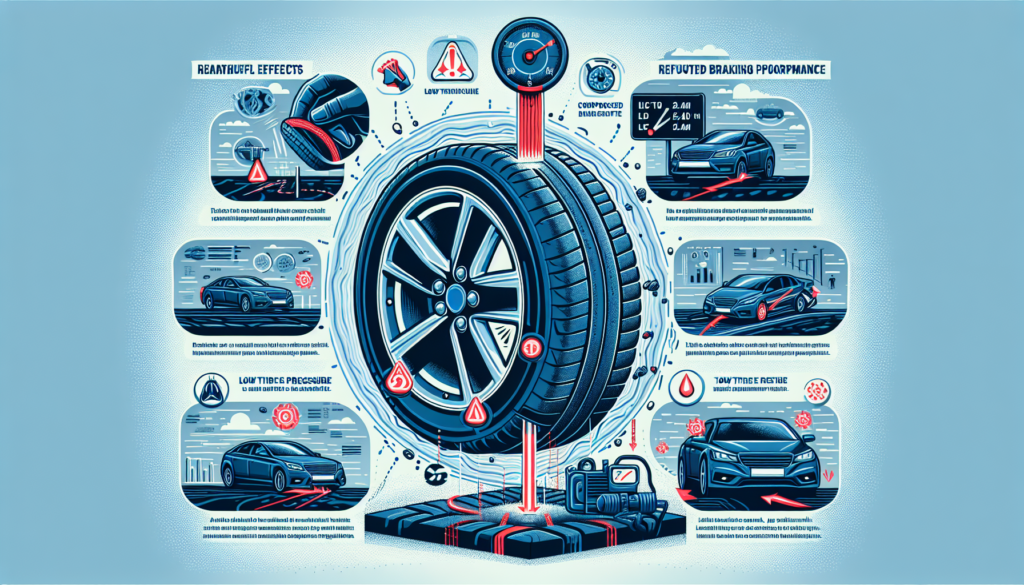Imagine driving down the road with a sense of stability and control, when suddenly you start to feel a slight wobble in your steering wheel. Your car seems to be drifting to one side, and your confidence behind the wheel diminishes. What could be causing this unnerving experience? It turns out that low tire pressure may very well be the culprit. In this article, we will explore how low tire pressure can impact the handling and stability of your vehicle and what you can do to avoid this common issue. Get ready to discover the key to a smoother and safer ride!
Impacts of low tire pressure on handling
When your tire pressure is too low, it can have a significant impact on your vehicle’s handling. Let’s explore some of the key ways that low tire pressure affects your ability to control your vehicle on the road.
Increased braking distance
One of the most noticeable impacts of low tire pressure on handling is the increased braking distance. When your tires are underinflated, the contact patch between the tire and the road is reduced. This means that less of the tire’s surface is in contact with the road, resulting in decreased traction and grip. As a result, it takes longer for your vehicle to come to a complete stop when you apply the brakes.
Reduced responsiveness
Another effect of low tire pressure is reduced responsiveness. When your tires are not properly inflated, they become less responsive to your steering inputs. This can manifest as delayed steering response, making it harder to navigate corners or make quick maneuvers. Additionally, underinflated tires can result in sluggish acceleration, making it more difficult to accelerate quickly when needed.
Decreased traction
Low tire pressure can also lead to decreased traction, particularly on wet or slippery surfaces. When your tires do not have sufficient air pressure, their ability to grip the road is compromised. This increases the chances of skidding or sliding, especially when navigating corners or making sudden stops. It is essential to have properly inflated tires to ensure maximum traction and control, especially in hazardous driving conditions.
Increased risk of hydroplaning
One of the most dangerous consequences of low tire pressure is the increased risk of hydroplaning. Hydroplaning occurs when your tires lose contact with the road surface and glide on a layer of water. When your tires are underinflated, the risk of hydroplaning becomes higher, as the shallow treads and reduced contact with the road make it easier for water to lift the tire off the ground. Hydroplaning can result in a loss of steering and braking control, posing a significant hazard in wet conditions.
Impacts of low tire pressure on stability
In addition to affecting your vehicle’s handling, low tire pressure also has a significant impact on its stability. Let’s delve into some of the ways that underinflated tires can compromise the stability of your vehicle.
Uneven weight distribution
One of the consequences of low tire pressure is uneven weight distribution. When your tires are not properly inflated, certain areas of the tire may bear more weight than others. This can lead to extra load on the sidewalls, causing increased wear on the outer edges of the tires. Unequal pressure distribution can result in compromised stability, making it harder to maintain control of your vehicle.
Increased body roll
Underinflated tires can contribute to increased body roll when navigating corners or making sharp turns. Soft and underinflated tires reduce the lateral stability of your vehicle, allowing the body to lean more heavily in one direction. This excessive body roll not only affects the comfort of your ride but also increases the risk of rollover accidents. Properly inflating your tires ensures greater stability and reduces the likelihood of dangerous body roll.
Reduced cornering ability
When your tire pressure is low, your vehicle’s ability to navigate corners safely is compromised. The decreased grip on the road surface makes it more challenging to maintain control during turns. Underinflated tires are more prone to slipping or skidding, increasing the risk of losing control of your vehicle. It is crucial to have properly inflated tires to ensure optimal traction and cornering ability, allowing you to navigate curves and corners with confidence.

1. Increased braking distance
Decreased contact patch
When your tire pressure is low, the contact patch between your tires and the road decreases. The contact patch refers to the portion of the tire that comes into contact with the road surface. With underinflated tires, the contact patch becomes smaller, reducing the amount of grip and traction available. This reduced contact patch impacts your braking distance, as less surface area is actively helping to slow down your vehicle.
Extended braking time
As the contact patch becomes smaller with low tire pressure, it takes longer for your vehicle to come to a complete stop. The decreased grip on the road surface means that your tires have less traction to effectively slow down the vehicle. This extended braking time can be dangerous, especially in emergency situations where every second counts. Properly inflated tires ensure a larger contact patch, allowing for quicker and more efficient braking.
Reduced grip on road surface
Underinflated tires have reduced grip on the road surface, which significantly impacts your braking ability. The lack of air pressure makes it more challenging for the tires to maintain proper traction. This reduced grip can result in longer stopping distances and increased chances of skidding during abrupt stops. Proper tire inflation is essential for maintaining optimal grip and ensuring your ability to stop safely and effectively.
2. Reduced responsiveness
Delayed steering response
When your tire pressure is low, you may experience a delayed steering response. Underinflated tires are less responsive to your steering inputs, resulting in a noticeable delay before your vehicle starts to turn. This delay can make it more challenging to navigate corners smoothly or make quick maneuvers. Properly inflated tires improve steering response, allowing for more precise and immediate control of your vehicle.
Sluggish acceleration
Low tire pressure can also lead to sluggish acceleration. When your tires are not properly inflated, they create more rolling resistance, meaning it takes greater effort and energy for the vehicle to move forward. This can make acceleration feel slower and less responsive. By maintaining the recommended tire pressure, you ensure that your tires roll efficiently, promoting smoother and more responsive acceleration.
Difficulty in controlling the vehicle
Underinflated tires can make it harder to control your vehicle overall. The reduced responsiveness, delayed steering response, and sluggish acceleration can all contribute to difficulty in maintaining control. This can be particularly problematic in emergency situations where quick reactions are required. Properly inflated tires improve vehicle control, allowing you to maneuver more confidently and effectively.

3. Decreased traction
Reduced grip on wet or slippery surfaces
One of the critical impacts of low tire pressure is decreased traction, particularly on wet or slippery surfaces. When your tires are underinflated, their ability to grip the road surface is compromised. This reduced grip can be especially dangerous in adverse weather conditions, where maintaining traction is crucial for safe driving. Proper tire inflation ensures optimal grip on wet or slippery surfaces, reducing the chances of skidding or sliding.
Increased chances of skidding or sliding
With underinflated tires, the risk of skidding or sliding increases significantly. The lack of proper air pressure compromises the tires’ ability to maintain grip, especially during sudden stops or turns. Skidding and sliding reduce your control over your vehicle, putting you at a higher risk of accidents. By keeping your tires properly inflated, you maximize traction and minimize the likelihood of skidding or sliding.
Decreased ability to navigate corners safely
Low tire pressure can make it more challenging to navigate corners safely. During turns, the tires need optimal grip to maintain control and stability. Underinflated tires have reduced grip on the road surface, which compromises their ability to effectively navigate corners. This decrease in grip can result in tires slipping or skidding, making it challenging to maintain control. Proper tire inflation is essential for ensuring maximum traction and cornering ability.
4. Increased risk of hydroplaning
Higher possibility of tire losing contact with the road
One of the most dangerous consequences of low tire pressure is the increased risk of hydroplaning. Hydroplaning occurs when a layer of water prevents your tires from maintaining contact with the road surface. Underinflated tires are particularly susceptible to hydroplaning because the shallow treads and reduced contact patch make it easier for water to lift the tire off the ground. This loss of contact puts you at a higher risk of losing control of your vehicle.
Loss of steering and braking control
When hydroplaning occurs, you can experience a complete loss of steering and braking control. With your tires gliding on a layer of water, your ability to turn the steering wheel or apply the brakes becomes severely compromised. This lack of control can have devastating consequences, especially in situations where quick reactions are necessary for avoiding an accident. Maintaining proper tire pressure is crucial for reducing the risk of hydroplaning and ensuring your ability to steer and brake effectively.
Dangerous in wet conditions
Low tire pressure poses a significant danger in wet conditions. Wet roads already reduce traction, and when combined with underinflated tires, the risk escalates further. The reduced grip and increased risk of hydroplaning make driving in wet conditions significantly more hazardous. Proper tire inflation plays a crucial role in providing the necessary traction and control needed to navigate safely on wet roads.

5. Uneven weight distribution
Extra load on the sidewalls
Underinflated tires lead to an uneven weight distribution among the tires. When your tires are not properly inflated, certain areas of the tire may bear more weight than others. This uneven weight distribution can result in additional load on the sidewalls of the tires. Over time, this can cause increased wear on the outer edges of the tires, compromising their overall performance and stability.
Increased wear on outer edges of tires
The extra load on the sidewalls of underinflated tires leads to increased wear on the outer edges of the tires. Uneven weight distribution can cause the tires to wear unevenly, with the outer edges experiencing more significant wear. This accelerated wear pattern not only reduces the lifespan of your tires but also impacts their ability to maintain stability and grip on the road.
Unequal pressure leads to compromised stability
When tire pressure is uneven, with some tires significantly underinflated compared to others, it can result in compromised stability. The uneven pressure distribution affects the way the vehicle sits on the road, making it harder to maintain control and stability. Proper tire inflation ensures that the weight is distributed evenly across all tires, maximizing stability and minimizing the risk of accidents.
6. Increased body roll
Soft and underinflated tires exaggerate body roll
Underinflated tires contribute to increased body roll when navigating corners or making sharp turns. When your tires lack the proper air pressure, they become softer and more flexible. This increased flexibility allows the body of your vehicle to lean more heavily in one direction, exaggerating the side-to-side motion during turns. This excessive body roll not only affects the comfort of your ride but also increases the risk of rollover accidents.
Lateral stability is compromised
The increased body roll resulting from underinflated tires compromises the lateral stability of your vehicle. Lateral stability refers to the ability to maintain control while moving from side to side, such as during cornering or lane changes. The excessive body roll caused by soft and underinflated tires reduces your vehicle’s ability to stay stable during these maneuvers, making it more difficult to maintain control on the road.
Higher risk of rollover accidents
When lateral stability is compromised due to underinflated tires, the risk of rollover accidents increases. Rollover accidents occur when a vehicle tips over onto its side or roof, often in situations where the lateral stability is severely compromised. Soft and underinflated tires contribute to an imbalance that can make your vehicle more vulnerable to rolling over, particularly during sharp turns or swerving maneuvers. Proper tire inflation is crucial for maintaining lateral stability and reducing the risk of rollover accidents.

7. Reduced cornering ability
Less grip on road during turns
Underinflated tires result in less grip on the road surface, which directly impacts your vehicle’s ability to navigate turns. During cornering, the tires need to maintain optimal contact with the road to ensure stability and control. With reduced grip, the risk of the tires slipping or skidding increases significantly, making it more difficult to maintain control and navigate turns safely. Proper tire inflation ensures maximum grip and enhances your vehicle’s cornering ability.
Risk of tires slipping or skidding
When your tire pressure is low, the chances of your tires slipping or skidding during turns become higher. The reduced grip on the road surface makes it harder for your tires to maintain traction, increasing the risk of losing control. Slipping or skidding during turns compromises your ability to navigate safely and can result in accidents. Maintaining proper tire inflation is essential for minimizing the risk of slipping or skidding and ensuring your ability to maintain control during turns.
Difficulty maintaining control in sharp curves
Low tire pressure can make it more challenging to maintain control while navigating sharp curves. The reduced grip and potential for tires to slip or skid during turns can result in difficulty maintaining stability. In sharp curves, where precise control is crucial, the risk of losing control of your vehicle becomes higher with underinflated tires. Proper tire inflation enhances your ability to maintain control and navigate sharp curves with confidence.
Conclusion
Low tire pressure has significant impacts on both handling and stability. From increased braking distance and reduced responsiveness to decreased traction and increased risk of hydroplaning, underinflated tires can compromise your control and safety on the road. Furthermore, uneven weight distribution and increased body roll undermine the stability of your vehicle, reducing cornering ability and increasing the risk of rollover accidents. It’s essential to maintain proper tire pressure to ensure optimal handling, stability, and overall safety behind the wheel. Regularly checking and inflating your tires to the recommended pressure levels will not only improve your driving experience but also contribute to a safer and more enjoyable journey.


